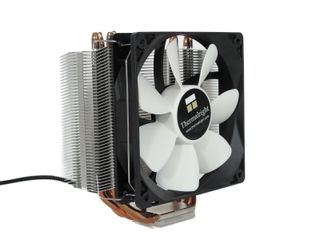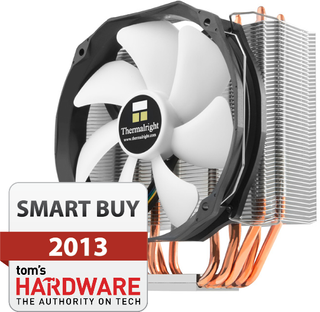Three Thermalright True Spirit Heat Sinks, Reviewed
Thermalright sent over all three models in its True Spirit heat sink family, complete with 92, 120, and 140 mm fans. We dropped each one onto an FX-8350 processor to gauge its cooling performance and acoustic output. Which one takes the value win?
Thermalright True Spirit: A Cooler Option For Every Budget
Thermalright’s True Spirit family includes thin-profile coolers in three distinct sizes, offering varying levels of performance, and selling at three different price points.

The compact Thermalright True Spirit 90M is available for as little as $26 on sites like SuperBiiz. It’s aimed at processors with TDPs of 90 W or less. We'd recommend adjusting this thermal solution's fan speed through your motherboard's firmware, since the bundled does get pretty loud if it's allowed to spin up beyond 2000 RPM. If you feel like you need the fan's full performance to keep your CPU cool enough, then there are better options out there, and you'll probably need to spend a little more for an ambitious overclock. We do want to point out that the back plate Thermalright bundles yields a very solid installation, which is not a given for a cooler of this size and budget.

The larger Thermalright True Spirit 120M(BW) sports four 6 mm heat pipes and stands only 145 mm tall. It performs well given its size, and is even suitable for light overclocking (more so than the 90M). Selling for as low as $43 on Amazon, it’s supposed to be a budget cooler that also performs well, and it does meet this challenge. Still, the bundled fan is very noticeable at full speed. We'd like to see it run more quietly and vibrate less. Dial the fan back 20% or so to 1000 RPM, and it's a lot more tolerable, though it gives up some performance in the process. The 120M(BW)’s strong suit is good compatibility due to its compact measurements and bent heat pipes.

Last up is the Thermalright True Spirit 140(BW). It’s the largest model in this heat sink family, sporting six 6 mm heat pipes and a height of 170 mm. This puts it in the enthusiast-oriented, overclocking-friendly, high-performance cooler segment.
Value is probably not the first thing that springs to mind when faced with its $50 price tag. But make no mistake; that's inexpensive considering the cooler’s performance level. You might be tempted to save a couple of bucks by buying the smaller 120M(BW), but the seven extra dollars you spend buys a lot of additional performance, which is important when you're gunning for a aggressive overclock on a system you plan to use daily. Its fan is also quieter than the other two models we reviewed, making it the most pleasant of the three coolers in practical use. Even at 100% duty cycle, the cooler did well in our acoustic benchmarks. In light of that, the Thermalright True Spirit 140(BW) secures our Smart Buy award for excellent performance at a
reasonable price.
Current page: Thermalright True Spirit: A Cooler Option For Every Budget
Prev Page Cooling Performance And Noise LevelStay on the Cutting Edge
Join the experts who read Tom's Hardware for the inside track on enthusiast PC tech news — and have for over 25 years. We'll send breaking news and in-depth reviews of CPUs, GPUs, AI, maker hardware and more straight to your inbox.
-
expl0itfinder I would love to see this compared against a wider selection of air coolers. For instance, the Cooler Master Hyper 212, or other fan favorites. Comparing it to 1 or 2 other brands does not give us a lot to look at.Reply -
Novuake A single other well known cooler for reference would have been great for easy context.Reply
Not all sites and reviews used Delta temps.
Nice review but kind of renders it moot for comparison out of the Silverstone and THermalright Scope. -
Someone Somewhere I think you got a bit lost on your graphs. At a guess, you meant to have one as distance from ambient, and one as absolute, or possibly there's idle readings.Reply
Also, please stick to the same units.
More comparisons would have been nice. -
SpadeM There are a few issues /omissions in the article, first being that the motherboard cap is only used on 939 sockets (i did an install for 970A-D3 AM3+ and it didn't require it) also the anchoring plate is flawed in my opinion because the screw holes that hold it in place aren't actually holes, but more live grooves on the outside of the plate and so the screws actually hold the plate in place with only half of their screw cap. And finally, for users that aren't experienced with multiple cpu heatsinks, tightening the final plate that locks the cooler in place ca very well damage your processor since there's no limiter in place.Reply
Other then that, those are some fantastic coolers, even though the thermal probe on FX-8350 under windows gives me flawed measurements in idle, under load it's quite good. -
iam2thecrowe 2000 rpm is noisy? i used to have a 6000rpm fan on my old athlon xp....... I think people these days are too picky about noise.Reply -
Someone Somewhere Reply11299459 said:2000 rpm is noisy? i used to have a 6000rpm fan on my old athlon xp....... I think people these days are too picky about noise.
Diameter has a lot to do with it - it's more to do with tip velocity than actual RPM. Your fan was likely about 40-50mm.
I've got 40mm fans that are near silent at 3K RPM. You can get 40mm fans that do 13K. -
ubercake Whether it's the motherboard or the heat sink manufacturers... We're still seeing 3rd-party CPU heat sinks and their fans blocking RAM slots for a decade. There's not much innovation going on here. I would tend to think the heat sink manufacturers need to accommodate the current motherboard designs. If they could solve that part of it in a full-size effective heat sink solution, innovation will have taken place. Until that time we'll keep seeing copper this; nickel-plated that; aluminum fins here; heat pipes there; one fan on this one; two fans on that.Reply
Same old stuff; different day. -
Myrkvidr @Someone Somwhere: Sorry, there's a copy&paste issue in the 2nd and 4th chart on page5: It should say "CPU temperature at 20°C ambient" while the 1st and 3rd chart are Delta temps.Reply
@SpadeM: Seems like I just did not RTFM close enough ;) But the measurement results were not affected by using or not using the plastic cap (I ran two separate measurement series). The anchoring plate is sitting very tight - I installed a lot of Thermalright heatsinks during the past couple of weeks. The contact pressure between the True Spirit heatsinks and the CPU is not excessively high, so it shouldn't cause any damage to the CPU.
@all: We just startet off with the new system for CPU cooler testing and had to start somewhere - there will be more results and coolers coming soon :)
